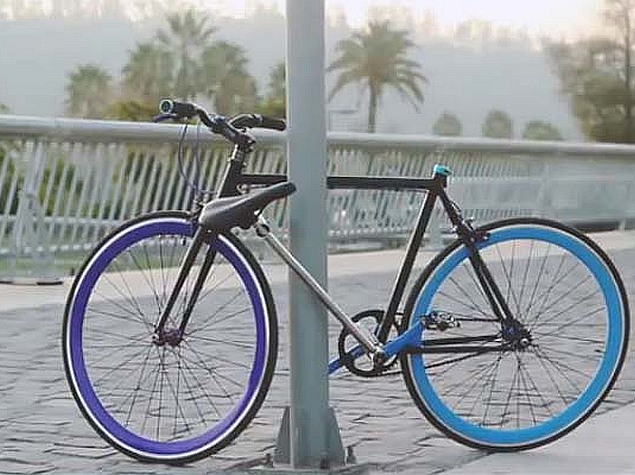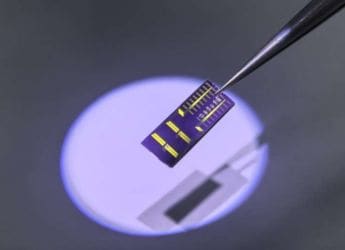- Home
- Science
- Science News
- Dutch Unveil World's First Solar Powered Bicycle Path
Dutch Unveil World's First Solar-Powered Bicycle Path

The Netherlands on Wednesday unveiled the world's first solar bike path, a revolutionary project to harvest the sun's energy that could eventually also be used on roads.
The so-called "SolaRoad" bike path is made of concrete modules each measuring 2.5 by 3.5 metres (eight by 11 feet), embedded with solar panels covered in tempered glass.
To help prevent accidents, the glass has been given a special non-slip surface.
The solar cells currently put the electricity they generate onto the national grid, but future plans include using the energy to power street lights.
Electric bikes and cars will one day be able to refuel using contactless charging directly from the road or bike path, said Sten de Wit, a physicist who helped develop the project.
"The idea is that in the Netherlands we have approximately 140,000 kilometres (87,000 miles) of road which is much bigger than all the rooftops put together," De Wit told AFP.
"We have 25,000 kilometres of bike paths in the Netherlands."
"If we can integrate it in our roads then we'll have huge extra potential for generating solar electricity," he said.
The path has been working for 16 days, during which it generated 140 kilowatt hours of electricity, equivalent to around 140 washing machine cycles, said SolaRoad spokeswoman Jannemieke van Dieren.
The project has so far cost three million euros ($3.7 million, roughly Rs. 23 crores), mainly for research, but SolaRoad declined to say what the cost per kilometre might be.
Dutch Economics Minister Henk Kamp cycled the first 70-metre (230-feet) pilot stretch of bike path on a busy provincial bicycle route north of Amsterdam on Wednesday.
"The Netherlands is quite ambitious when it comes to sustainable energy. This innovation is an important part of it," Kamp told AFP afterwards.
The small country of 18 million - most of them cyclists - hopes to triple sustainable energy usage by 2020 and be "energy neutral" by 2050, Kamp said.
The SolaRoad will be tested over the next two years on a path that carries around 2,000 cyclists a day, De Wit said.
The aim is to have the solar road commercially available on Dutch roads within the next five years as the number of electrically-powered cars and bicycles grows.
"We are very confident that in five years we will have a product we can apply on a large scale," De Wit said.
Get your daily dose of tech news, reviews, and insights, in under 80 characters on Gadgets 360 Turbo. Connect with fellow tech lovers on our Forum. Follow us on X, Facebook, WhatsApp, Threads and Google News for instant updates. Catch all the action on our YouTube channel.
Related Stories
- Samsung Galaxy Unpacked 2025
- ChatGPT
- Redmi Note 14 Pro+
- iPhone 16
- Apple Vision Pro
- Oneplus 12
- OnePlus Nord CE 3 Lite 5G
- iPhone 13
- Xiaomi 14 Pro
- Oppo Find N3
- Tecno Spark Go (2023)
- Realme V30
- Best Phones Under 25000
- Samsung Galaxy S24 Series
- Cryptocurrency
- iQoo 12
- Samsung Galaxy S24 Ultra
- Giottus
- Samsung Galaxy Z Flip 5
- Apple 'Scary Fast'
- Housefull 5
- GoPro Hero 12 Black Review
- Invincible Season 2
- JioGlass
- HD Ready TV
- Laptop Under 50000
- Smartwatch Under 10000
- Latest Mobile Phones
- Compare Phones
- OnePlus 15R
- Realme Narzo 90x 5G
- Realme Narzo 90 5G
- Vivo S50 Pro Mini
- Vivo S50
- OPPO Reno 15c
- Redmi Note 15 5G
- Redmi Note 15 Pro 5G
- Asus ProArt P16
- MacBook Pro 14-inch (M5, 2025)
- Infinix Xpad Edge
- OnePlus Pad Go 2
- OnePlus Watch Lite
- Just Corseca Skywatch Pro
- Acerpure Nitro Z Series 100-inch QLED TV
- Samsung 43 Inch LED Ultra HD (4K) Smart TV (UA43UE81AFULXL)
- Asus ROG Ally
- Nintendo Switch Lite
- Haier 1.6 Ton 5 Star Inverter Split AC (HSU19G-MZAID5BN-INV)
- Haier 1.6 Ton 5 Star Inverter Split AC (HSU19G-MZAIM5BN-INV)

















